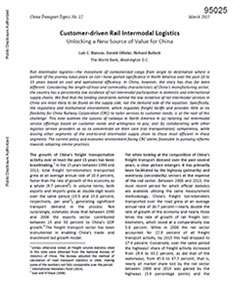The World Bank Company Profile

The World Bank is a vital source of financial and technical assistance to developing countries around the world. We are not a bank in the ordinary sense but a unique partnership to reduce poverty and support development. The World Bank Group comprises five institutions managed by their member countries.
Follow The World Bank on social media

The World Bank
1818 H Street, NWWashington, DC 20433
United States
(202) 473-1000
(202) 477-6391
Downloads

In this report, the authors addresses three questions concerning recent trade developments: what is happening?; why?; and does it matter?...

The decline in oil prices has significant macroeconomic, financial and policy implications, and if sustained, it will support activity and...

China, and its national railway operator China Railway Corporation (CRC), are in the midst of a particularly favorable environment towards...

160 Countries Ranked on Trade Logistics - Connecting to Compete report finds large gap persists between best and worst performing countries.
The World Bank News & Resources
Page 1 of 2 pages.

Increased Policy Uncertainty & Maturing Global Value Chains Weakened 2016 Trade Growth
February 23, 2017
Trade developments in 2016 reflected a number of factors including slow global growth and low commodity prices, as well as increased policy uncertainty and maturing global value chains, 2016 is the fifth consecutive year of slow trade growth and the year with the weakest performance in trade since the global financial crisis.

Trade Developments in 2016
February 23, 2017
In this report, the authors addresses three questions concerning recent trade developments: what is happening?; why?; and does it matter? The report is organized into 2 chapters: chapter one presents trade developments in 2016; and chapter two presents trade and productivity slowdowns: the role of global value chains.

U.S. Oil Closes Below $40 a Barrel for 1st Time in Nearly 4 Months
August 2, 2016
Oil prices fell again today, erasing early gains and dragging U.S. crude below $40 a barrel as persistent worries of a glut offset the boost from a weak dollar early in the session.

Crude Oil Crashes Below $30 a Barrel for the First Time in 12 Years
January 12, 2016
Oil dropped below $30 a barrel in New York for the first time in 12 years on concern that turmoil in China’s markets will curb fuel demand.

Understanding the Plunge in Oil Prices: Sources and Implications
January 10, 2016
The decline in oil prices has significant macroeconomic, financial and policy implications, and if sustained, it will support activity and reduce inflationary, external, and fiscal pressures in oil-importing countries.

Customer-Driven Rail Intermodal Logistics: Unlocking a New Source of Value for China
March 21, 2015
China, and its national railway operator China Railway Corporation (CRC), are in the midst of a particularly favorable environment towards reforming the rail intermodal sector.

Containers on Rail: China’s Next Big Opportunity in Supply Chain Logistics
March 21, 2015
Since 1998, freight container traffic in China has grown faster than the rate of economic growth - while container traffic on trucks and ships has increased, the use of trains for part of the journey, known as rail intermodal logistics, has decreased.

Why Oil Prices Keep Falling - And Throwing The World Into Turmoil
February 4, 2015
The oil price crash is now upending the global economy, with ramifications for every country in the world.

Connecting to Compete 2014 - Trade Logistics in the Global Economy
March 21, 2014
160 Countries Ranked on Trade Logistics - Connecting to Compete report finds large gap persists between best and worst performing countries.

Logistics Performance Index (LPI) Report: The Gap Between Best and Worst Persists
March 21, 2014
The LPI and its supply chain related components help countries understand the challenges that they and their trading partners face in making their national logistics perform strongly.

Doing Business 2014: Latin America
December 30, 2013
The data contained in this report not only highlights the extent of obstacles to doing business; they also help identify the source of those obstacles, supporting policy makers in designing regulatory reform.

Focus on Latin America: The Seaborne Advantage
December 29, 2013
New entrants in the market will rely heavily on a mix of hub-and-spoke network configurations as well as interlining between long-distance shipping routes using transshipments through the Caribbean Triangle.

Focus on Latin America: Brazil, Argentina, Chile
December 29, 2013
Global 3PL Mallory Alexander International Logistics has examined the relative strengths and weaknesses of the transport networks in three major trading nations and points to the complexity U.S. shippers must deal with in the coming years.

Focus on Latin America: Transportation and Regulatory Infrastructure
December 29, 2013
Before entering this vibrant marketplace, trade experts advise logistics managers to conduct a careful examination of the region’s transportation and regulatory infrastructure.
América Latina: Supply Chain & Logistics Opportunities Abound, but Proceed with Care
December 28, 2013
Before entering this vibrant marketplace, trade experts advise logistics managers to conduct a very careful examination of the region’s transportation and regulatory infrastructure.

